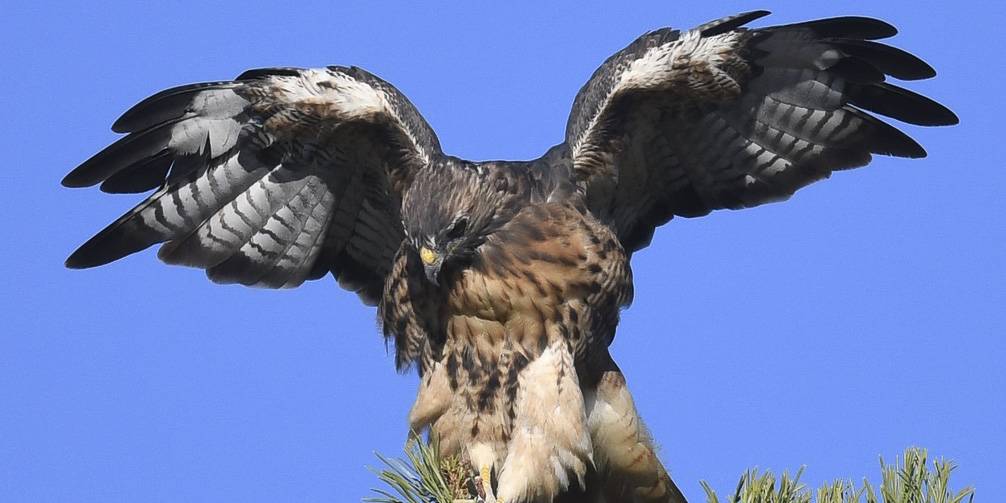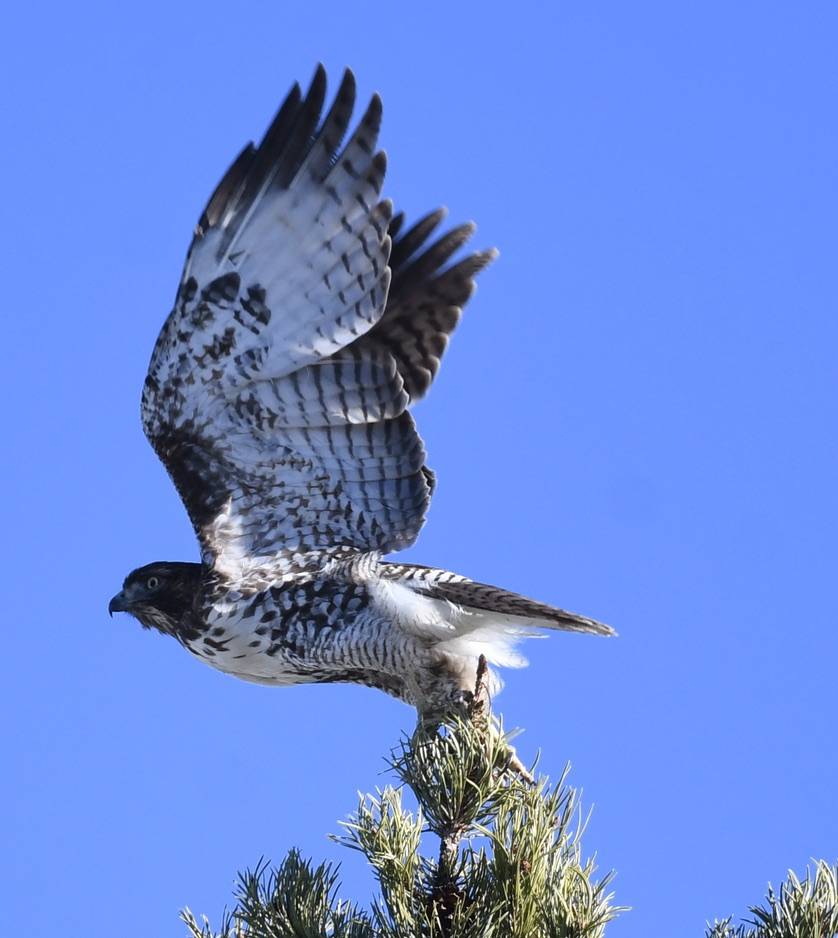(Buteo jamaicensis)
By Sevilla Rhoads

Almost every time you walk the trails around the airport and stables, you can see one or more Red-tailed Hawks. Perhaps you spot them perched on the fence posts or trees. Or, more likely, they are soaring above you. A growing body of research finds human minds and bodies benefit from experiencing awe. Fortunately, no matter how many times we see them cut masterfully through our skies, the Red-tailed Hawk’s aerial strength and grace is a constant source of awe and wonder. Especially with Sunriver’s background of snowy volcanic peaks, a Red-tailed Hawk effortlessly riding the invisible winds can remind us of Olympic figure skaters.
Although Red-tailed Hawks are one of the country’s largest birds, even the biggest ones rarely weigh more than three pounds. Being so light is one reason these hawks excel in the air. They are one of the few species that can kite into the wind. Kiting is when a bird uses air currents to stay in place while barely moving its wings. When you see a hawk kiting on a strong wind, you might think your eyes are deceiving you because the bird appears to defy gravity by hanging motionless in the sky.
As you marvel at a Red-tailed’s aerial performance or admire one regally perched on the edge of a meadow, you might notice some of them do not have red tails. In fact, the more you notice the markings on these hawks, you realize some look quite different than others. The Red-tailed may be one of the most commonly observed and widespread U.S. birds of prey, but it comes in so many variations that you could never say that if you’ve seen one, you’ve seen them all. Scroll through photographs of the different ways Red-tailed Hawks can present in this area and it is hard to believe they are all the same species. While the broad range of appearances can frustrate when trying to accurately identify the species, the wide variety of looks makes Red-tailed watching more fun and interesting.
Red-tailed Hawks are skilled hunters with around ninety-percent of their diet consisting of rodents. Sunriver’s hawks and owls devour countless rats, mice, ground-squirrels, and voles making them one of our best lines of defense for rodent control. With these birds as allies in your own attempts to control rodents, check your pest control methods are bird safe. In a study published in 2020, the Tufts School of Veterinary Medicine found a hundred percent of Red-tailed Hawks autopsied at their clinic had rat poison in their systems.
You recognize the call of a Red-tailed Hawk because it is featured in so many movies. Their haunting cry also frequently features in commercials. To the frustration of many birders, almost every time a bird of prey, regardless of the species, appears in a movie or advertisement, a Red-tailed Hawk call is dubbed over the actual sound. Apparently the media industry finds Bald Eagle calls too wimpy to match their image, so, more often than not, the eagle on the screen opens its bill and out comes the more glamorous voice of the Red-tailed Hawk. There is an amusing Bird Note on this topic: https://www.birdnote.org/listen/shows/stephen-colberts-bald-eagle. We often have both Bald Eagles and Red-tailed Hawks calling over Sunriver, so be sure you consult an actual bird guide rather than rely on general media to distinguish the calls from each other.
On quite a few occasions while walking in Sunriver, we thought we heard a Red-tailed Hawk, but, despite carefully searching, we could not locate it. Then, a bright blue Stellar’s Jay appears, opens its bill, and screams just like a hawk! Stellar Jays often imitate other birds and there are many accounts and some studies regarding their impersonation of hawks and eagles. Some say the jays use predator calls to warn off intruders, but many think there may be more reasons for this behavior not yet understood by science.
Throughout human history are stories of connections between Red-tailed Hawks and humans. Some oral traditions of the Nuwä (Kawaiisu or Southern Paiute) feature the Red-tailed Hawk (called Kwanazi in their language). Some Native American tribes have legal rights to collect the hawk’s red tail feathers for ceremony and traditional dress.
American falconers, past and present, have hunted with Red-tailed Hawks. Many falconers train and hunt with juvenile Red-tailed Hawks then release them back into the wild when they are fully mature. The mortality rate for Red-tailed Hawks in their first two years is around eighty percent, so these falconers feel they are giving their birds a better chance to survive. Falconers like Rodney Stotts share their Red-tailed and other hawk experiences with others to help inspire and support communities with less access to nature. For more about Stotts’ community work with Red-tailed Hawks, see https://rodneysraptors.webs.com/about
As you watch for Red-tailed Hawks around Sunriver, you will discover there are a number of other bird of prey species here, including our winter residents, the Rough-legged Hawks. We also have Red-shouldered Hawks which, especially when juvenile, can look a lot like a small Red-tailed. You may also spot a Cooper’s, Northern Harrier, or Sharp-shinned Hawk or even some other less frequently seen hawks for our area. Plus, we have falcons like the Prairie, Merlin, and Peregrine and other birds of prey like Ospreys which hunt and breed here in the summer. It can be hard to tell all these birds of prey apart, but it is a nice problem to have so many raptors from which to choose as you scour your bird guide!

Identification Tips
A large bird of prey with broad rounded wings and a short tail which appears wide in flight. There are many plumage variations based on age, season, location, and other reasons including sub-species. Often seen gliding on thermals or perched on the edge of open spaces. Adults are usually brown above with a reddish tail, but pale below with a band of brown on the belly, dark wing tips and brown ‘shoulders’ stretching about a quarter to half the way along the wing from the neck. On many, the head appears mostly brown with a paler chin. Juveniles can have striped brown tails and more brown flecks on the chest.
For more information see: https://www.allaboutbirds.org/guide/Red-tailed_Hawk/
